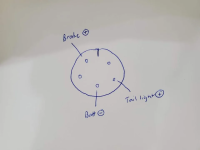The max wattage of any lights I’ve looked at is 45w for the headlight and way less for the taillight. But even at 90w still relatively low.
If the 90w is at "12v" then the current is 90 / 12 = 7.5A. Half that for 45w. Etc. If the device is constant power, internally regulated, then the higher the voltage input the lower the current draw will be. If it is not, then the higher the voltage the higher the current draw will be and the higher the wattage consumed by the device. (most things are the latter)
If it's a literal 12v dc-dc, then it will be 12.0v output.
If it's an automotive 12v, it should be about 13.6v output.
If it's something else...you'd have to measure it. It probably doesn't say, so this is safest.
If the lights you're using are DOT 12v devices, then they almost certainly are rated for anything from around 10v to 15v input, and if not internally constant-power-regulated will be brighter the higher the voltage is, and dimmer the lower it is.
If they're unspecified, they're probably resistively-current-limited (if even that) and get brighter and hotter the higher the voltage, so the closer to "12v" they are the more likely they are to operate as designed/advertised.
The super73 dc controller appears to be something custom as it has the "Green" input plug but multiple outputs including a circuit that turns on from the controller enabling the tailight+ (Which runs the headlight and tailight) as well as a circuit that is enabled from the brake+ pin that goes out to the brake input of the tailight. The headlight I want is standard on off, the tailight is either 3 pin or 5 pin depending on if I want to add the blinker/turn indicator function. For the simplicity of this Im really just trying to figure out the best way to enable a 12v circuit using the brake+ from the controller but using single dc converter.
Once you know what the actual signals are from the green plug, then we can work out the wiring and parts needed.
If all your lighting runs from 12v DC-DC converter, then essentially the signals from the plug will just power relay coils. The relays themselves will then switch the 12v on/off to the various lights.
If the headlight and taillight will be always on if hte bike is on, no relay or control signal is needed for htem. They are simply wired directly to the 12v DC-DC converter output, and the DC-DC's input is wired directly to the switched side of the bike battery, so they turn on as soon as the battery is on.
If the H&T will only be on under specific conditions, then if you list those conditions we can figure out what hardware and wiring is needed to make that happen. For instance:
To start it looks like the tailight+ and batt- would be the inputs to the 48v/12v dc controller. This would enable 12v power when the lights were enabled from the switch on the handlebar.
Is this switch connected to anything right now? If so, what exactly is it wired to, with what voltage, and what current limit does it have? What happens when the switch is on vs off? (does it ground a connection, or supply power to it? Is it a momentary switch, or latching? Does it switch from one electrical connection to a different one, or just make or break a single one? Etc.).
I would need to split the output from the 12v+ where one goes the tailight+ and the 12v negative to tailight-.
There's no need to "split" the output into + and -, because it already is (if it wasn't, you couldn't run anything from it as there is no way to get current flow).
If you mean something else, you might need to draw it up, or better describe it.
What is the best methodology to switch the circuit of the 2nd 12v+ line based on the Brakelight+ coming out of the controller? Would a MOSFET work vs a relay?
Depending on the available signals from your control source (green plug), I would just use an actual relay. A FET switch may require other parts to ensure the gate is always correctly driven, doesn't spike and blow the gate, heatsink for the FET depending on it's resistance and the current flow thru it and airflow past it, etc. A relay just needs a reverse-biased diode across it's coil so it doesn't cause problems with whatever signal drives it, and sufficient current to make the coil pull in the contacts.
There are also modules available with solid state switches, relays, FETs, etc., each with different control signal options, and different output switching options, and ways to connect the wires to them. There's almost certainly one that will do what you want once we know what that is.

What I really need to find out is what's the voltage of the taillight and brake light pins. If they are 5v output then they could trigger a MOSFET I believe.
If the FET is designed for 5v signal switching, yes, but there are other considerations as noted above. Some FETs are made with logic-level gates, many are not and require specific amounts of gate drive signal to operate them as switches (vs amplifiers).


